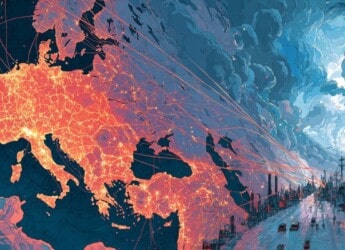|
|
Content Assessment: Starved for Victory? Ukraine Conflict Assessments in Maps (April 19 – 21, 2022)
Information - 96%
Insight - 95%
Relevance - 92%
Objectivity - 90%
Authority - 91%
93%
Excellent
A short percentage-based assessment of the qualitative benefit of the post highlighting the recent Ukraine conflict assessments in maps from the Institute for the Study of War.
Editor’s Note: One of the most accurate and detailed sources for ongoing updates on the Ukraine crisis is the Ukraine Conflict Update from the Institute for the Study of War. The Institute for the Study of War (ISW) is a 501(c)(3) organization and produces strictly non-partisan, non-ideological, fact-based research. ISW seeks to promote an informed understanding of war and military affairs through comprehensive, independent, and accessible open-source research and analysis. ISW’s research is made available to the general public, military practitioners, policymakers, and media members. Providing a daily synthesis of key events related to the Russian aggression against Ukraine, ISW updates may benefit cybersecurity, information governance, and legal discovery professionals as they follow the business, information technology, and legal trends and trajectories impacted by and stemming from the current Ukraine conflict.
Assessment and Maps*
Ukraine Conflict Assessments – An Overview in Maps
- Institute for the Study of War (ISW), Russia Team
- Critical Threats Project (CTP), American Enterprise Institute
General Assessment Background Info
- ISW systematically publishes Russian campaign assessments that include maps highlighting the assessed control of terrain in Ukraine and main Russian maneuver axes.
- These maps augment daily synthetic products that cover key events related to renewed Russian aggression against Ukraine.
Russian Offensive Campaign Assessment on April 21, 2022
Extract (Mason Clark, George Barros, and Kateryna Stepanenko)
The Kremlin declared victory in the battle of Mariupol. Russian forces will attempt to starve out remaining Ukrainian defenders in the Azovstal Steel Plant rather than clear it through likely costly assaults. Russian President Vladimir Putin and Defense Minister Sergei Shoigu declared victory in the battle of Mariupol on April 21 despite the continued presence of Ukrainian forces in Mariupol’s Azovstal Steel Plant. In a staged, televised meeting, Putin ordered Shoigu to halt assaults on the plant to limit Russian casualties, claiming Russian forces have already captured the entirety of the city. The Kremlin will spin the (still incomplete) capture of Mariupol into a major victory in Ukraine to compensate for stalled or failed Russian offensives elsewhere.
The Kremlin’s reduction of the pace of operations in Mariupol is unlikely to enable the deployment of significant combat power to support other offensive operations in the coming days and weeks. Statements from US officials that Russia has not yet removed a dozen battalion tactical groups (BTGs) from Mariupol despite Putin’s claimed victory do not capture either the status of these Russian forces or other constraints on their use.[1] ISW has consistently assessed that Russian BTGs have taken high casualties in the battle of Mariupol, are degraded, and are unlikely to possess their full complement of personnel (800-900 at full strength). As with Russian operations elsewhere in Ukraine, reporting on numbers of BTGs without additional context and analysis of the combat power of these units is not a useful evaluation of Russian forces. While it is unlikely that all 12 reported BTGs were involved in the final fighting around the Azovstal plant, it will still take some time for those units that were engaged in final assaults to disengage for redeployment elsewhere. Some portion of these Russian forces will be necessary for several other missions—including maintaining the siege of the Azovstal plant, securing the rest of Mariupol against any remaining pockets of Ukrainian forces and likely partisan actions, and possibly redeploying to support Russian forces maintaining control of southern Ukraine. Russian forces will certainly be able to redeploy some units from Mariupol to offensive operations elsewhere—but Ukrainian forces have succeeded in tying down and degrading a substantial Russian force, and the Kremlin’s declaration of victory has not inherently freed up 12 BTGs worth of combat power for other operations.
Key Takeaways
- The Kremlin’s declaration of victory in Mariupol is unlikely to enable the deployment of significant combat power to reinforce offensive operations in eastern Ukraine in the coming days or weeks.
- Russian forces involved in the battle of Mariupol are likely heavily damaged and Ukrainian forces succeeded in tying down and degrading a substantial Russian force.
- Russian forces continued offensive operations in eastern Ukraine but made only marginal gains.
- Ukrainian forces continued to halt Russian attacks around Izyum.
We do not report in detail on Russian war crimes because those activities are well-covered in Western media and do not directly affect the military operations we are assessing and forecasting. We will continue to evaluate and report on the effects of these criminal activities on the Ukrainian military and population and specifically on combat in Ukrainian urban areas. We utterly condemn these Russian violations of the laws of armed conflict, Geneva Conventions, and humanity even though we do not describe them in these reports.
Ukraine Conflict Maps - 041922-042122
Read the latest Ukraine Conflict updates from the Institute for the Study of War
* Shared with direct express permission from the Institute for the Study of War (ISW).
About the Institute for the Study of War Research Methodology
ISW’s research methodology relies on both primary and secondary sources, enabling researchers to develop a comprehensive understanding of the situation on the ground. In order to analyze military and political developments in any given area, ISW’s research analysts must wholly understand the systems of enemy and friendly forces. They must also understand the population demographics, physical terrain, politics, and history of that area. This lays the analytical foundation for understanding the reasons for particular developments and fulfilling their assigned research objectives. ISW analysts also spend time in places like Iraq, Afghanistan, and elsewhere in order to gain a better understanding of the security and political situation and to evaluate the implementation of current strategies and policies. Our researchers compile data and analyze trends, producing a granular analysis of developments in areas of research, producing an accurate, high-resolution, timely, and thorough picture of the situation. ISW’s research methodology guarantees its success and commitment to improving the nation’s ability to execute military operations, achieve strategic objectives, and respond to emerging problems that may require the use of American military power.
About the Institute for the Study of War
The Institute for the Study of War advances an informed understanding of military affairs through reliable research, trusted analysis, and innovative education. We are committed to improving the nation’s ability to execute military operations and respond to emerging threats in order to achieve U.S. strategic objectives. ISW is a non-partisan, non-profit, public policy research organization. Learn more, get involved, and contribute today.
Additional Reading
- [Annual Update] International Cyber Law in Practice: Interactive Toolkit
- Data Embassies: Sovereignty, Security, and Continuity for Nation-States
Source: ComplexDiscovery
























